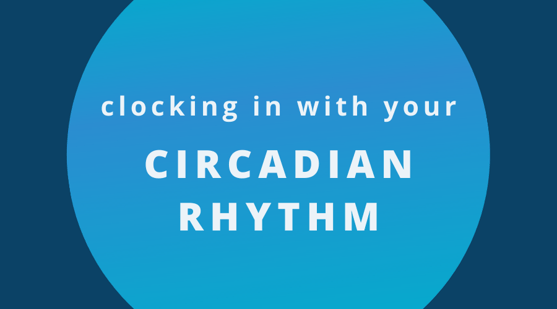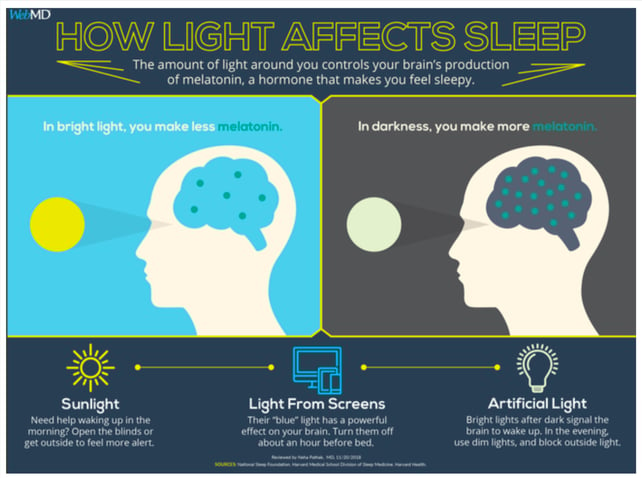
Circadian rhythm refers to the body’s 24-hour biological clock under which our bodies respond to the light-and-dark cycle, making us alert during the day and tired at night. Daily responses to the exposure of light include physical, mental, and behavioral changes.
In the mornings, we receive daylight from the sun that helps create a hormone called cortisol, acting as a wake-up call to be alert during the day. At night, when exposed to the dark, a hormone called melatonin is released and makes us tired and ready for sleep.
Upon the invention of artificial light and advances in electric lighting technology, people are no longer restricted to daytime hours and the setting sun. While artificial lighting has boosted our productivity, it has also created an environment that is no longer in sync with our circadian rhythms, therefore disrupting our circadian health and presenting a host of potential long-term health issues as a result. The electric light we work and live under does not match the dynamic nature of the sun’s light, which provides a bright, blue-toned light in early mornings and a warm, low-level light in evenings, our cue to rest.
Health Impacts
Research indicates that electric light impacts our circadian rhythms. For example, scientists discovered that long-term exposure to blue light can reduce melatonin production. Some indoor sources of blue light include smartphones, tablets, TVs, and computer monitors.
Sleep disruption can also be linked to “depression, bipolar disorder, post-traumatic stress disorder, generalized anxiety, and other mood disorders”.2

Source: https://www.webmd.com/sleep-disorders/sleep-blue-light
Looking for a few additional ways to manage your usage of blue light? Check out these tips provided by WebMD:1
- Blue light-blocking glasses [...] Amber or brown-tinted lenses may help best
- Cut back on screen time starting 2-3 hours before bed
- Dim the brightness on your devices [...]
- Install blue light-filtering apps on smartphone, tablet, and computer screens. They filter a lot of blue light from reaching your eyes without making it harder to see the display
- Swap light bulbs. LEDs give off more blue light than fluorescent bulbs [...]
- Use a dim red lightbulb as a nightlight. Red is the color that least affects your circadian rhythm
- Set an alarm for 1 hour before bed to remind yourself to quit using devices
Alzheimer’s disease can also be linked to a disrupted circadian rhythm. The National Library of Medicine states that often “sleep-related pathological symptomatology”3 accompanies Alzheimer’s. The connection between the two also includes “neuroinflammation, neurodegeneration, and circadian rhythm desynchronization”.3 Having a balanced circadian rhythm could actually aid in the diagnosis of Alzheimer’s due to the “timely recognition of sleep-specific symptoms”.3
Circadian Rhythm + Lighting
To mitigate negative effects of electric light on our health, lighting professionals have begun to take on the idea of circadian lighting as a hot new topic. The concept of circadian lighting is to have an electric lighting system designed to send the brain sufficient light signals, mimicking the natural dynamic light we would typically receive from the sun. Circadian lighting is shown to promote healthy sleeping patterns and good quality sleep, as well as other long-term health benefits.
Lighting professionals can use daylight as the benchmark for circadian lighting system designs. By mimicking the dynamic light the sun provides with interior lighting using new knowledge and features of LED technology, we can create personalized lighting environments to improve overall health and wellbeing.
Key considerations to implementing a circadian lighting system include intensity tuning, color tuning and stimulus tuning. These systems could allow an individual to adjust light levels and color temperatures accordingly. With discussions related to circadian rhythm, several lighting manufacturers have begun to implement LED products in the market that support circadian health.
Connecting Circadian Rhythm and Energy Efficiency
Color tuning in LED technology allows us to adjust the hue of white light to appear warmer or cooler. While this helps simulate natural daylight, it does not actually meet our bodies biological needs and fails to synchronize our circadian rhythms. Traditional white LEDs were designed for vision and energy efficiency, and do not deliver the blue-light wavelengths from natural daylight to support our circadian system and keep us alert.
With new knowledge of circadian lighting and the continuous goal towards energy efficiency, the lighting industry now needs to optimize circadian lighting systems to be both energy efficient and supportive of human health and productivity.
Modern electric lighting systems for human environments should be optimized around four key objectives: illumination, human health, human productivity, and energy efficiency. Illumination is light that allows us to carry out tasks, accurately renders color, and is aesthetically pleasing. The systems should also provide light that supports human health by synchronizing circadian rhythm during the day and preventing disruption at night, and support human productivity by stimulating alertness, cognitive performance and mood. Last but not least, it is important that the lighting we use in these systems maximizes energy efficiency.6
This introduces the idea of ‘spectrally optimized LEDs’, where the spectral sensitivity within the visible light spectrum is optimized alongside the four objectives mentioned above. They are designed to target our biological responses and help regulate our circadian rhythms. These LED systems can create white light that provides daytime stimulus without changing color throughout the day.5 Alternatively, a lighting system could be designed to allow simultaneous tuning of both color performance and circadian character for varying environments, while maintaining a good luminous efficacy. The system would combine both white and monochromatic LEDs, enough to stimulate circadian action as well as color performance.7
Reset Your Circadian Rhythm
Through the reduction of blue light, LED lights, and screen time, a balanced circadian rhythm can be achieved and results can be seen almost instantly. Reducing these can help aid in better sleep habits, ultimately leading to better mental health and overall health.
Circadian rhythm not only affects sleep but also hormones, immune system, and digestion.
How do you know when it’s time to reset your circadian rhythm? If having trouble falling asleep, staying awake in the evening, waking up in the morning, or focusing on day to day activities, it may be time for a circadian rhythm reset.
To reset your circadian rhythm, try out these tricks from the Cleveland Clinic:4
- Have a routine
- Exercise
- Avoid alcohol and caffeine in the evening
- Limit screen time
- Avoid naps
- Gradually move your bedtime
Coauthored with Amanda Marchione, Marketing Specialist, Encentiv Energy
Sources
1 How Blue Light Affects Your Sleep
2 Circadian rhythm disruption and mental health
3 Circadian Rhythm and Alzheimer’s Disease
5 What is circadian lighting and how does it work
6 LEDs must spectrally balance illumination, circadian health, productivity, and energy efficiency
.png?width=500&name=2019%20e%20news%20spotlight%20logo%20(1).png)




